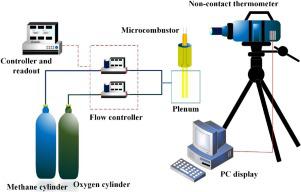Chemical Engineering and Processing: Process Intensification ( IF 3.8 ) Pub Date : 2020-11-02 , DOI: 10.1016/j.cep.2020.108207 Evans K. Quaye , Jianfeng Pan , Qingbo Lu , Yi Zhang , Yu Wang , Anthony Akurugo Alubokin

|
A three-dimensional numerical and experimental study on methane-oxygen combustion has been conducted in a small scale porous-media cylindrical combustor which aims at extending the optimized controlling parameters for thermophotovoltaic power application. Different equivalence ratios, inlet velocities, porous-media porosities and wall thermal conductivities are simulated in the same configuration and the results show that porous-media improves the thermal characteristics of a combustor compared to the non-porous-media counterpart. There is about 350 K difference in peak wall temperature for the porous-media combustor over the non-porous-media combustor. The flame temperature first increases as porosity increases, and then slightly decreases as the porosity increases. At higher wall thermal conductivities, the effect of the change in porosity does not affect the mean temperature distribution on the combustor wall. Based on the findings, the porous-media combustor with equivalence ratio of 0.8, porosity of 0.5, inlet velocity of 0.35 m/s and wall thermal conductivity of 20 W/(m2219;K) are identified as key combustion conditions that can produce uniform and stable wall temperature for an efficient combustion chamber for the thermophotovoltaic system. With the inherent constraint associated with small-scale combustion this study will provide a premise for developing and enhancing the performance of the combustor under the given constraints.
中文翻译:

圆柱形多孔介质燃烧器中甲烷甲烷混合气燃烧特性的研究
在小型多孔介质圆柱型燃烧器中进行了甲烷-氧气燃烧的三维数值和实验研究,目的是扩展用于热光伏发电应用的优化控制参数。在相同的配置中模拟了不同的当量比,入口速度,多孔介质孔隙率和壁热导率,结果表明,与无孔介质相比,多孔介质改善了燃烧室的热特性。多孔介质燃烧器的壁温峰值与非多孔介质燃烧器的壁温峰值相差约350K。火焰温度首先随着孔隙率的增加而增加,然后随着孔隙率的增加而略微降低。在较高的壁导热率下,孔隙率变化的影响不会影响燃烧室壁上的平均温度分布。根据这些发现,确定当量比为0.8,孔隙率为0.5,入口速度为0.35 m / s和壁导热率为20 W /(m2219; K)的多孔介质燃烧器是能够产生均匀燃烧的关键燃烧条件。稳定的壁温,为热光电系统提供了高效的燃烧室。有了与小规模燃烧相关的固有约束,本研究将为在给定约束下开发和增强燃烧器性能提供前提。35 m / s和20 W /(m2219; K)的壁导热率被确定为关键燃烧条件,可为热光伏系统的高效燃烧室产生均匀且稳定的壁温。有了与小规模燃烧相关的固有约束,本研究将为在给定约束下开发和增强燃烧器性能提供前提。35 m / s和20 W /(m2219; K)的壁导热率被确定为关键燃烧条件,可为热光伏系统的高效燃烧室产生均匀且稳定的壁温。有了与小规模燃烧相关的固有约束,本研究将为在给定约束下开发和增强燃烧器性能提供前提。











































 京公网安备 11010802027423号
京公网安备 11010802027423号